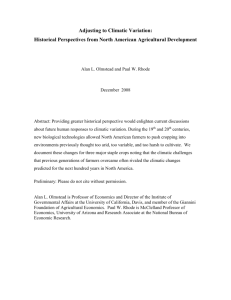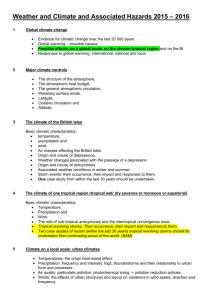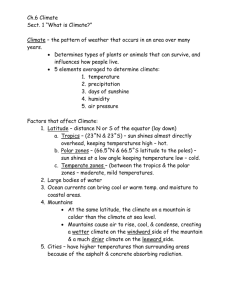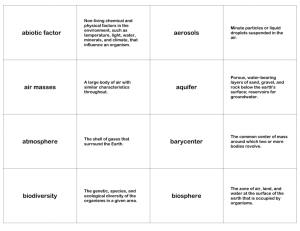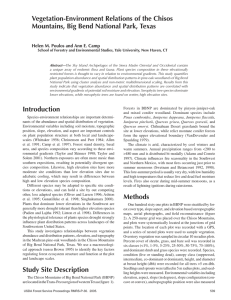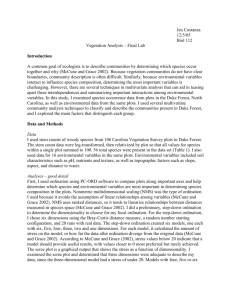Annex 1. Figure 1. Phylogenetic tree of the tree species included in
advertisement
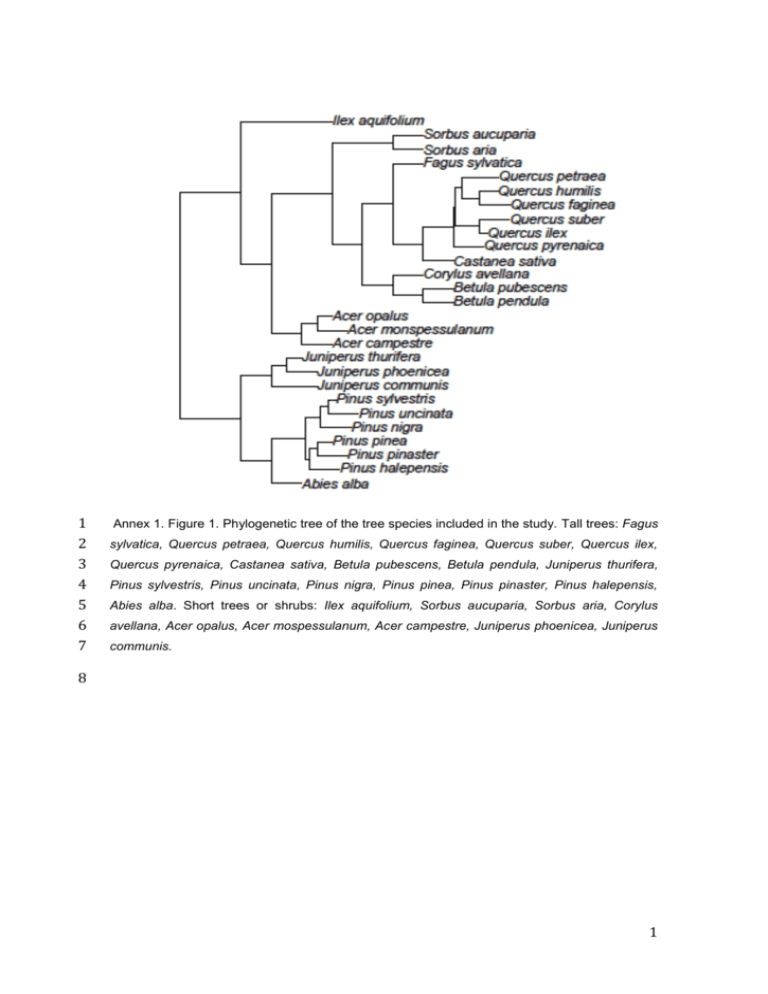
1 2 3 4 5 6 7 Annex 1. Figure 1. Phylogenetic tree of the tree species included in the study. Tall trees: Fagus sylvatica, Quercus petraea, Quercus humilis, Quercus faginea, Quercus suber, Quercus ilex, Quercus pyrenaica, Castanea sativa, Betula pubescens, Betula pendula, Juniperus thurifera, Pinus sylvestris, Pinus uncinata, Pinus nigra, Pinus pinea, Pinus pinaster, Pinus halepensis, Abies alba. Short trees or shrubs: Ilex aquifolium, Sorbus aucuparia, Sorbus aria, Corylus avellana, Acer opalus, Acer mospessulanum, Acer campestre, Juniperus phoenicea, Juniperus communis. 8 1 9 Annex 2. Methods 10 11 12 Climatic suitability modelling. Climatic, topographic and radiation variables. 13 14 15 16 17 18 19 20 21 22 We undertook a climate regionalization through GIS modeling using ground data (1950–1998; 1068 thermometric and 1999 precipitation meteorological stations) from the Spanish weather monitoring system (National Weather Institute; http://www.aemet.es) (see Ninyerola et al., 2007a, b; Keenan et al., 2011 for details), resulting in 200m spatial resolution maps. Future regionalized climate was obtained using an approximation based on differences between the current climate (CRU; New et al., 1999) and the climate projection from the HadCM3 model using the A1 storyline. Topographic variables (slope and aspect) were obtained through standard GIS terrain modelling from a digital elevation model (DEM) at 200m spatial resolution. Solar radiation was computed using astronomic equations, DEM and meteorological stations (Pons and Ninyerola, 2008). 23 24 25 Climatic suitability modelling. Model calculations. 26 27 28 29 30 31 32 33 34 35 36 37 The climate niche model of each species was built after exploring a large number of variables. Correlations between explanatory variables of species presence/absence above 0.70 led to the elimination of one of the variables, selecting the most comprehensive and integrative one. For each run, the GLM algorithm chose the best combination of variables according to the Akaike Information Criterion (AIC). The most repeated set of variables in the 250 runs was chosen for the final model, which consisted of a regression (suitability model) using the averaged regression coefficients of the 250 runs. Model calibration was performed by using 80% of the plots from each dataset. Accuracy was estimated with the remaining 20% of the plots, using the area under the ROC curve parameter (AUC; Fielding and Bell, 1997). The final model accuracy was computed using the average of the 250 runs, providing good results (AUC >0.85). Model calculations were performed using R software (R Development Core Team 2010). 38 39 40 41 2 42 References 43 44 45 Fielding AH, Bell JF (1997) A review of methods for the assessment of prediction errors in 46 47 48 Kearney M, Phillips BL, Tracy CR, Christian KA, Betts G, Porter WP (2008) Modelling species 49 50 51 New M, Hulme M, Jones PD (1999) Representing twentieth century space-time climate 52 53 Ninyerola M, Pons X, Roure JM (2007a) Objective air temperature mapping for the Iberian 54 55 56 Ninyerola M, Pons X, Roure JM (2007b) Monthly precipitation mapping of the Iberian Peninsula 57 58 Pons X, Ninyerola M (2008) Mapping a topographic global solar radiation model implemented in 59 R Development Core Team (2010) conservation presence/absence models. Env Conserv 24: 38-49 distributions without using species distributions: the cane toad in Australia under current and future climates. Ecography 31: 423-434 variability. Part 1: development of a 1961–1990 mean monthly terrestrial climatology. J Clim 12: 829–856 Peninsula using spatial interpolation and GIS. Int J Clim 27: 1231–1242 using spatial interpolation tools implemented in a Geographic Information System. Theor Appl Clim, 89: 195–209 a GIS and refined with ground data. Int J Clim 28: 1821–1834 3 Climatic Average 2 Cs Bu Ca Qs 1 MAP MAT Pp Ia Axis 2 Ac Pi 0 Qi Ph Jp Pn Jc Qp Sa P/ETP Ao Qy Am Qh Qf Fs Su Ps Aa Bp -1 Jt Pu -2 -3 -2 -1 0 1 2 Axis 1 60 61 62 63 64 Annex 3. PCA ordination of average climatic characterization of species. The variance accounted by the first and second components were 77.4% and 19.2%, respectively. MAT, mean annual temperature; MAP, mean annual precipitation; P/ETP, ratio between precipitation to potential evapotranspiration for June – August. Species abbreviations as in Figure 2. 65 4 Climatic Amplitude 2 Qi Pi Axis 2 1 Jc BuQh MAT SD Qf Ph Jp 0 Jt Pn -1 Bp Su Qp Aa Qy Ps Qs P/ETP SD Ao Pu Ia MAP SD Sa Ca Fs Ac Am Pp Cs -2 -4 -3 -2 -1 0 1 2 Axis 1 66 67 68 69 70 71 Annex 4. PCA ordination of climatic amplitude characterization of species. The variance accounted by the first and second components were 56.6% and 27.0%, respectively. MAT SD, standard deviation of annual temperature; MAP SD, standard deviation of annual precipitation; P/ETP SD, standard deviation of the ratio between precipitation to potential evapotranspiration for June-August. Species abbreviations as in Figure 2. 72 73 5 Functional Traits 3 Qi Jp 2 Qs Axis 2 1 Jt Ia Jc 0 Ph -1 Pu Pp -2 Pi Pn Qf Am Sa WD Qh SM SLA LA Su Nmass Qy Ca Qp Cs Ao Ac Hmax Bu Fs Ps Bp Aa -3 -3 -2 -1 0 1 2 3 Axis 1 74 75 76 77 78 79 80 81 Annex 5. PCA ordination of functional traits of species. The variance accounted by the first and second components were 45.8% and 23.7%, respectively. Hmax, maximum tree height; WD, wood density; SLA, specific leaf area, Nmass, nitrogen content of leaves, LA, leaf area, SM, seed mass. Species abbreviations as in Figure 2. 82 83 6


